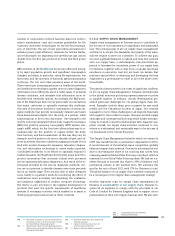Siemens 2011 Annual Report Download - page 158
Download and view the complete annual report
Please find page 158 of the 2011 Siemens annual report below. You can navigate through the pages in the report by either clicking on the pages listed below, or by using the keyword search tool below to find specific information within the annual report.
6 A. To our shareholders
23 B. Corporate Governance 51 C. Combined management’s discussion and analysis
52 C. Business and operating environment
80 C.2 Fiscal – Financial summary
83 C. Results of operations
101 C. Financial position
114 C. Net assets position
117 C. Overall assessment of the economic position
118 C. Report on post-balance sheet date events
119 C. Report on expected developments and
associated material opportunities and risks
135 C. Information required pursuant to Section ()
and Section () of the German Commercial
Code (HGB) and explanatory report
mon Siemens technology platforms, such as Totally Integrated
Automation, or TIA. The Sector provides vertical market offer-
ings based on its close relationships with customers and in-
depth knowledge of their business challenges – an approach
that differentiates the Industry Sector from its competitors.
Our new Infrastructure & Cities Sector bundles various tech-
nologies and businesses under one roof in order to offer cities
and infrastructure customers innovative and sustainable solu-
tions. The business portfolio includes transportation, logis-
tics, building and smart grid technologies to improve energy
efficiency, infrastructure productivity and quality of life. Cities
are among our most important customers, representing an ar-
ea where we foresee strong growth. Sustainable urban infra-
structures are just as important for rapidly growing megaci-
ties as they are for large and medium-sized cities all over the
world. As an integrated technology organization, our Infrastruc-
ture
& Cities Sector builds on a large portfolio of green infra-
structure technologies to meet the needs of its customers.
Financial Services (SFS) has three strategic cornerstones:
supporting Siemens‘ business activities by providing financ-
ing solutions to customers of the Sectors, generating profit
through financing activities within Siemens‘ domains, and
managing the financial risks of Siemens. SFS combines financ-
ing expertise with asset know-how in the Siemens domains.
C.. Financial performance measures
This section on financial performance measures describes
several measures that are or may be non-GAAP financial mea-
sures. Other companies that report or describe similarly titled
financial measures may calculate them differently. For further
information about these measures, please see C. Addition-
al information for supplemental financial measures.
As of the beginning of fiscal , we introduced One
Siemens – our framework for sustainable value creation;
for further information see C... Strategy of the Siemens
Group. As part of One Siemens, we have developed a financial
target system for capital-efficient growth that we believe will
drive the value of our Company. Our goal is to achieve contin-
uous improvement relative to the market and our competi-
tors. The financial target system of One Siemens defines indi-
cators for revenue growth, capital efficiency and profitability,
the optimization of our capital structure, and our dividend
policy. In addition, we set hurdle rates that generally need to
be considered before acquisitions are executed.
C... REVENUE GROWTH
We believe that an important driver for increasing our Compa-
ny ’s value over the long term is profitable revenue growth.
Specifically, our goal is to grow our revenue faster than the av-
erage revenue growth of our most relevant competitors. For
purposes of comparison to the revenue growth of our com-
petitors, our revenue growth is calculated as the growth rate
of reported revenue (as presented in the Consolidated Finan-
cial Statements). In fiscal and reported revenue
growth was % and ()%, respectively. Revenue growth ad-
justed for currency translation and portfolio effects was %
and ()% for fiscal and , respectively.
C... CAPITAL EFFICIENCY AND PROFITABILITY
Our aim is to work profitably and as efficiently as possible
with the capital of our shareholders and lenders. As part of
One Siemens, we monitor our capital efficiency using adjust-
ed return on capital employed, or ROCE (adjusted), which is
reported on a continuing operations basis. This measure as-
sesses our income generation from the point of view of our
shareholders and lenders. ROCE (adjusted) is defined as in-
come from continuing operations before interest after tax di-
vided by average capital employed. For information on the
calculation of ROCE (adjusted) and its components, see C.
Additional information for supplemental financial measures.
Our target is to achieve a ROCE (adjusted) of % to %.
Siemens’
weighted average cost of capital (WACC) is currently
estimated at approximately .%. ROCE (adjusted) in the fiscal
years and was .% and .%, respectively.
In line with common practice in the financial services indus-
try, return on equity after tax, or ROE (after tax), is used
as our financial indicator for measuring capital efficiency at
Revenue growth
FY
Actual 7%
Adjusted 7%
FY
Actual (2)%
Adjusted (3)%
1 Adjusted for currency translation and portfolio effects.
Revenue current period
– 1 × 100%
Revenue prior-year period
























